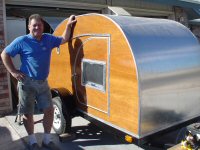ninerhb wrote:brian_bp wrote:wlooper89 wrote:I am not 100 percent sure about this but believe the 50A service can also power 240 volt appliances if the RV is wired for it, using the two 120V wires. My adapter pigtail has a four pin plug on the 50A end and three on the 30A end.
Yes, the 30A side as line, neutral, and ground pins; the 50 A side has two lines, neutral, and ground. In the 50A system 120V power is obtained between either line and neutral, and I assume that line-to-line should be 240V, just as in a similar residential circuit. I have not seen a 240V appliance in an RV, but perhaps someone has them.
This keeps getting repeated, but it's not quite correct. 50A and 30A just refer to the carrying capacity of the wires/plugs. Either size plug/wire can come in two configurations - 120V or 240V (30A does, I don't know about 50A). You can get twice the power using a 240V plug with only one more wire, because the two legs are out of phase and thus they can share a ground and neutral line. If RV plugs are using standard 240V twistlock (or heaven forbid, stove or dryer) outlets, then they're required to supply the proper out of phase power to the two 120v poles - if they're not, they're out of code. Of course, if you get two 120v standard outlets, there's no guarantee that they're in or out of phase, or even on different circuits.
A general sort order of power is:
50A/240 > 30A/240 > 50A/120 > 20A/240 > 30A/120 > 20A/120 > 15A/120
(There is one benefit of a 30A/120 over a 20A/240 - if you want to bring your welder along and need 25A, you can't get that from the higher-powered outlet.)
HenryB
I assumed that we were talking about common
RV connections, especially since we were specifically discussing an RV 50A-to-30A adapter. Maybe I should have explicitly stated that.
Yes, there are 240V-only configurations with two hot lines and no neutral, 120/240V configs with two hot lines and a neutral, and 120V-only configs with one hot line and one neutral. Any of these could be 30A, 50A, or some other current rating. Any of those many combinations might be available in twist-lock and straight pin types. For instance, I had a 50A 240V (no neutral) socket in my garage for a welder... not something that would be used with an RV.
The "standard" configurations are defined by
ANSI and
NEMA in a standard called
WD 6 - see
NEMA connector at Wikipedia for an overview. You can buy a printed copy (for $144) or download it from NEMA free of charge.
In the RV world, the post at the campsite, and thus the cord that comes with the RV, typically comes in only two configurations over 20A, which are the two styles I listed:
NEMA 14-50 - 50A @ 120/240V (I have this on my fifth-wheel trailer)
NEMA TT-30 30A @ 120V (I have this on my 17-foot travel trailer)
Often, the RV's cord is detachable from the RV (such as on my fifth-wheel), and detachable 50A cords usually use a twist-lock connector at the inlet to the RV (presumably a NEMA L14-50)... but the other end of the cord is the normal non-twist NEMA 14-50. See a typical
Marinco 50A cord and
inlet for an example (mine are the same, but my cord is black).
By the way, and ordinary household socket is a NEMA 5-15R.
... and everywhere I put 120V really should be 125V (the rating of the devices), although the power supplied is typically somewhere between 110V and 120V.


